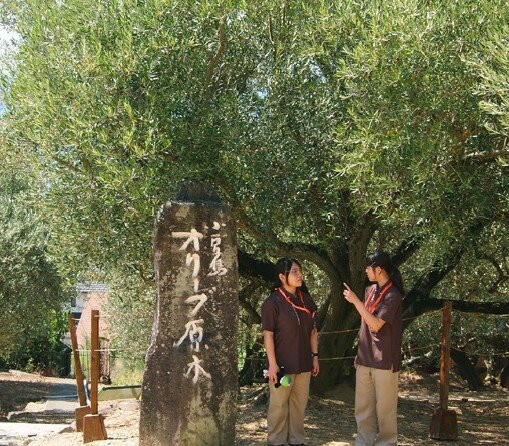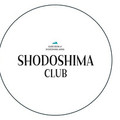的点评
We interviewed them beneath Japan's oldest olive tree, which was planted in Nishimura in 1917 for industrial use.
Olive Beach的点评
点评:Olive cultivation began on Shodoshima 116 years ago. After experiencing the First Sino-Japanese War and the Russo-Japanese War, the Meiji government, recognizing the importance of stable supply chains for resources, implemented a national policy in 1908 (Meiji 41) to conduct experimental olive cultivation in Mie, Kagoshima, and the Nishimura district of Shodoshima. With the collaboration of industry, academia, and government, Shodoshima was the only location where the cultivation succeeded.
Later, Suzumushi Kōyu Shōten (now Shimamura Co., Ltd.) became the first private entity in Japan to establish an “olive garden” in this area, starting the production and sale of olive oil for culinary and cosmetic purposes. The original tree used in the cultivation experiments still stands in the garden today. Over a century later, this serene location in the Nishimura district continues to uphold its legacy, now thriving as a tourist farm where visitors can enjoy strolling, dining, and purchasing historically significant olive cosmetics and edible oils. It has become a beloved destination for many.
Over 116 years ago, olive cultivationbegan on Shodoshima, and today,
the Olive Garden continues this legacy,
attracting visitors for its scenic beautyand products. Ms. Shiota and Ms. Toyoda,
who grew up on the island, joined theOlive Garden last year and are passionate
about conveying the “true charm of Shodoshima.”
Ms. Toyoda and Ms. Shiota, both raised on Shodoshima and recent employees
of the Olive Garden, began working
with olives in high school through parttime
harvest jobs. Toyoda, who loves
illustration, creates characters to promote
olives, while Shiota, passionate about
customer interactions, aims to serve as
a guide for the island’s charm. Both feel
typical phrases like "Island of Healing"
are vague and are determined to uncover
Shodoshima’s true appeal.
They hope to share the island’s unique
qualities not only with tourists but also
with former residents, encouraging
them to return. Shiota says, “Instead of
stopping people from leaving, we should
make it easy for them to come back when
they’re ready.” They also welcome
newcomers who appreciate the island’s
charm despite its inconveniences.
Finally, both expressed a desire for a
space where their generation can gather
to discuss the island’s future, much like
community center gatherings they
admire. Their efforts reflect a commitment
to defining and sharing Shodoshima’s
essence for future generations.
Later, Suzumushi Kōyu Shōten (now Shimamura Co., Ltd.) became the first private entity in Japan to establish an “olive garden” in this area, starting the production and sale of olive oil for culinary and cosmetic purposes. The original tree used in the cultivation experiments still stands in the garden today. Over a century later, this serene location in the Nishimura district continues to uphold its legacy, now thriving as a tourist farm where visitors can enjoy strolling, dining, and purchasing historically significant olive cosmetics and edible oils. It has become a beloved destination for many.
Over 116 years ago, olive cultivationbegan on Shodoshima, and today,
the Olive Garden continues this legacy,
attracting visitors for its scenic beautyand products. Ms. Shiota and Ms. Toyoda,
who grew up on the island, joined theOlive Garden last year and are passionate
about conveying the “true charm of Shodoshima.”
Ms. Toyoda and Ms. Shiota, both raised on Shodoshima and recent employees
of the Olive Garden, began working
with olives in high school through parttime
harvest jobs. Toyoda, who loves
illustration, creates characters to promote
olives, while Shiota, passionate about
customer interactions, aims to serve as
a guide for the island’s charm. Both feel
typical phrases like "Island of Healing"
are vague and are determined to uncover
Shodoshima’s true appeal.
They hope to share the island’s unique
qualities not only with tourists but also
with former residents, encouraging
them to return. Shiota says, “Instead of
stopping people from leaving, we should
make it easy for them to come back when
they’re ready.” They also welcome
newcomers who appreciate the island’s
charm despite its inconveniences.
Finally, both expressed a desire for a
space where their generation can gather
to discuss the island’s future, much like
community center gatherings they
admire. Their efforts reflect a commitment
to defining and sharing Shodoshima’s
essence for future generations.
翻译:小豆岛的橄榄种植始于116年前。经历了甲午中日战争和日俄战争后,明治政府认识到稳定的资源供应链的重要性,于1908年(明治41年)实施国家政策,在三重县、鹿儿岛县和小豆岛县西村地区进行橄榄种植实验。在产学官的合作下,小豆岛是唯一成功种植的地方。
后来,铃虫保健商店(现岛村株式会社)成为日本第一个在该地区建立“橄榄园”的民间企业,开始生产和销售用于烹饪和美容目的的橄榄油。种植实验中使用的原始树木至今仍矗立在园中。一个多世纪后,西村区这处宁静的地点继续传承着自己的传统,如今已成为一个蓬勃发展的旅游农场,游客可以在这里漫步、用餐,并购买具有历史意义的橄榄化妆品和食用油。它已成为许多人心爱的目的地。
116 多年前,橄榄种植开始于小豆岛,如今,橄榄园延续了这一传统,以其美丽的风景和产品吸引着游客。在岛上长大的 Shiota 女士和 Toyoda 女士去年加入了橄榄园,她们热衷于传达“小豆岛的真正魅力”。
Toyoda 女士和 Shiota 女士都是在小豆岛长大的,也是橄榄园的近期员工,她们从高中开始通过兼职采摘工作与橄榄打交道。热爱插画的丰田通过创作人物形象来推广橄榄,而热衷于与顾客互动的盐田则致力于成为小岛魅力的向导。两人都觉得“治愈之岛”等典型短语太过模糊,并决心发掘小豆岛的真正魅力。他们希望不仅与游客分享小豆岛的独特品质,也与前居民分享,鼓励他们再次光临。盐田说:“我们不应该阻止人们离开,而应该让他们准备好时轻松回来。”他们也欢迎新来者,尽管小豆岛存在诸多不便,但他们仍然欣赏小豆岛的魅力。最后,两人都表达了希望有一个空间,让他们这一代人可以聚集在一起讨论小豆岛的未来,就像他们所钦佩的社区中心聚会一样。他们的努力反映了他们致力于为子孙后代定义和分享小豆岛的精髓。
后来,铃虫保健商店(现岛村株式会社)成为日本第一个在该地区建立“橄榄园”的民间企业,开始生产和销售用于烹饪和美容目的的橄榄油。种植实验中使用的原始树木至今仍矗立在园中。一个多世纪后,西村区这处宁静的地点继续传承着自己的传统,如今已成为一个蓬勃发展的旅游农场,游客可以在这里漫步、用餐,并购买具有历史意义的橄榄化妆品和食用油。它已成为许多人心爱的目的地。
116 多年前,橄榄种植开始于小豆岛,如今,橄榄园延续了这一传统,以其美丽的风景和产品吸引着游客。在岛上长大的 Shiota 女士和 Toyoda 女士去年加入了橄榄园,她们热衷于传达“小豆岛的真正魅力”。
Toyoda 女士和 Shiota 女士都是在小豆岛长大的,也是橄榄园的近期员工,她们从高中开始通过兼职采摘工作与橄榄打交道。热爱插画的丰田通过创作人物形象来推广橄榄,而热衷于与顾客互动的盐田则致力于成为小岛魅力的向导。两人都觉得“治愈之岛”等典型短语太过模糊,并决心发掘小豆岛的真正魅力。他们希望不仅与游客分享小豆岛的独特品质,也与前居民分享,鼓励他们再次光临。盐田说:“我们不应该阻止人们离开,而应该让他们准备好时轻松回来。”他们也欢迎新来者,尽管小豆岛存在诸多不便,但他们仍然欣赏小豆岛的魅力。最后,两人都表达了希望有一个空间,让他们这一代人可以聚集在一起讨论小豆岛的未来,就像他们所钦佩的社区中心聚会一样。他们的努力反映了他们致力于为子孙后代定义和分享小豆岛的精髓。

此点评仅代表旅行者个人的主观意见,并不代表TripAdvisor以及其合作方的意见。
关于我们
|
新闻动态
|
商务合作
|
会员中心
|
业主中心
|
业主通
|
常见问题
|
意见反馈
|
联系我们
|
营业执照
© 2025 Tripadvisor 版权所有。
使用条款 |隐私政策 |网站工作原理
部分照片由 VFM Leonardo 提供。
* Tripadvisor不是旅行社,也不是旅游预订服务代理商。我们提供免费、客观、公正的旅游资讯服务。 (显示更多)
TripAdvisor LLC 既不是预订代理商,也不是旅游运营商,不会向网站用户收取任何服务费。 按照规定,在 Tripadvisor 发布机票价格、游览和旅行套餐的合作伙伴(航空公司、旅行提供商及预订代理商),其标价须包含所有费用和附加费用。 例如, 机场出入境税费、消费税与其他服务费、手续费、杂费及附加费用。 当您向我们的某个合作伙伴进行预订时,请务必查阅他们的网站以了解当地行政部门要求的所有适用费用的具体情况。 除非另有说明,机票价格通常指的是一个人的价格(以人民币计)。
为方便起见,TripAdvisor LLC 根据从我们的预订合作伙伴获取的空房率计算每个酒店的均价。 对于游览和景点来说,所显示价格通常是每位成人的最低可用价格。 对于列出的任何旅行套餐或优惠,TripAdvisor LLC 无法保证任何特定的费率或价格。 此外,酒店均价每晚会更新,并以您的首选币种表示(使用现行汇率)。 由于这些已换算的价格是预估价格,因此,有关具体金额和币种请与预订网站进行核实。
此外,TripAdvisor LLC 无法保证我们网站上宣传的价格随时有效。 标价可能需要预订一定天数才能生效,或有不可用日期、使用条件或限制。
TripAdvisor公司对外部网站的内容一概不负责。优惠价格中不含税和其他费用。
ICP证:沪B2-20200433
沪ICP备20013175号
 沪公网安备31010502005427号
沪公网安备31010502005427号鹰程信息技术(上海)有限公司
货币/国家及地区
¥CNY
中国

